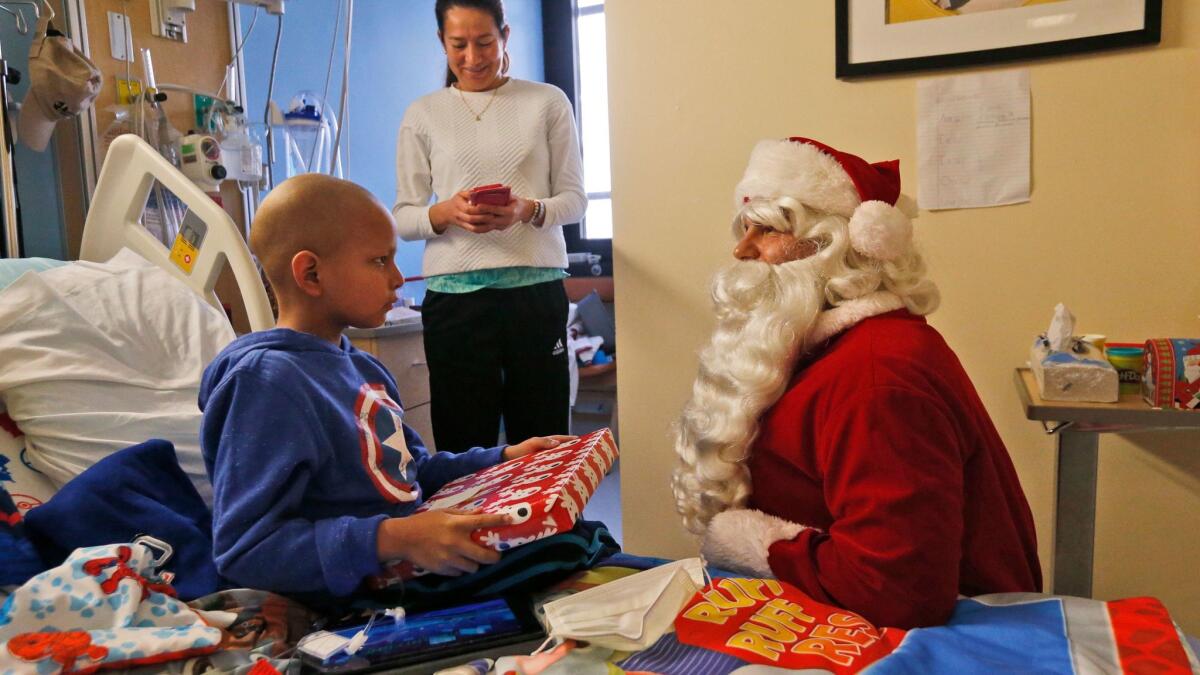Santa’s Christmas gift-giving has nothing to do with whether kids are naughty or nice, study shows

- Share via
Hey kids, grown-ups have been telling you a big lie about Santa Claus.
It’s not about whether he’s real — he is, of course! — but about whom he decides to visit.
The lie is so pervasive that it’s included in one of the most popular songs this time of year, “Santa Claus is Coming to Town.” The lyrics in question go something like this:
He’s making a list
And checking it twice;
He’s gonna find out who’s naughty or nice
Santa Claus is coming to town
He sees you when you’re sleeping,
He knows when you’re awake,
He knows if you’ve been bad or good,
So be good for goodness sake!
Actually, Santa doesn’t seem to care whether you’ve been bad or good. A new study suggests that the best predictor of whether you’ll rate a visit from St. Nick on Christmas is whether you live in a region of social and economic deprivation.
A team led by John J. Park of the Harvard T.H. Chan School of Public Health tested the theory that Santa favors nice kids over naughty ones by focusing on kids who spent last Christmas in the hospital, reasoning that “sick children are the most deserving of a visit from Santa Claus,” they wrote in their study.
The researchers called all 191 hospitals in the United Kingdom with pediatric wards and asked to speak to someone who had been on duty on Dec. 25, 2015. Nearly all of the hospitals complied, but five were excluded from the study because either their wards had closed or none of their staffers were interested in getting to the bottom of this pressing public policy question.
Of the 186 hospitals included in the analysis, 168 — or 90% — said that Santa had paid a visit last Christmas. That included all eight hospitals with pediatric wards in Northern Ireland and all but one of the hospitals in Scotland and Wales. In England, a country with 151 hospitals that cared for children, 135 — or 89% — received Christmas visits from Santa.
The researchers had no way of knowing whether the child patients in those hospitals had behaved themselves over the course of the year. So as a proxy for naughtiness and niceness, they looked at official government crime rates for kids between the ages of 10 and 17, which were available for most parts of the United Kingdom. They also checked rates of school absenteeism for primary schools throughout the U.K.
A statistical analysis turned up no correlation between either of these factors and the odds of Santa visiting a hospital.
So the researchers considered the distance between each hospital and the North Pole, figuring that Santa might be more likely to visit the wards that were closer to his workshop. Again, there was no correlation.
Finally, they considered a measure of “socioeconomic deprivation” for each region that incorporated factors like income, employment, education levels, crime and health status. Regions were placed into one of 10 groups, which were ranked from least to most deprived. This revealed a relationship between socioeconomic factors and Santa’s travel schedule.
For the entire United Kingdom, moving up one rung in socioeconomic deprivation was associated with 23% greater odds that Santa would be a no-show on Christmas. In a second analysis focused solely on England, each increase in deprivation was associated with a 31% increased risk of being snubbed by Santa, the researchers found.
All of the hospitals in the five most deprived groups were less likely to be visited by Santa than the hospitals in the four groups that were least deprived.
The results are strong enough to undermine the widely held belief that Santa cares about children’s behavior, the study’s authors wrote. Still, it would be good to confirm this in the future with “better individual level estimates of naughtiness in children,” they wrote. (It would also be helpful to consider factors like the quality of whiskey provided to Santa at various hospitals, whether chimneys are available for him to come down and whether the National Health Service has enough parking spaces to accommodate Rudolph and the rest of the reindeer, they added.)
In the meantime, the research findings are poised to have an immediate impact on children’s behavior, according to the researchers. They warned parents to brace themselves for “a possible increase in outbursts of bad behavior by children over Christmas if they find out.”
The study was published Wednesday in the Christmas issue of the journal BMJ.
Follow me on Twitter @LATkarenkaplan and “like” Los Angeles Times Science & Health on Facebook.
MORE IN SCIENCE
How NORAD became the world’s official Santa-tracker
Sorry, Pokemon Go addicts, playing the video game doesn’t count as a real workout
Proved at last: Men really are idiots




